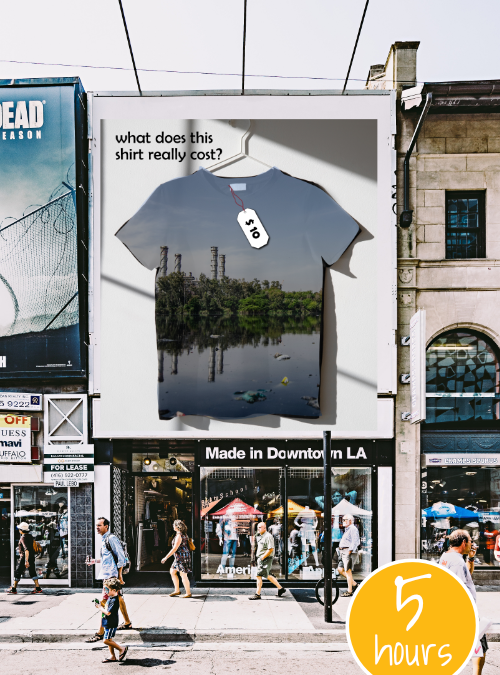
Image produced by Algalita with photos by: Anna Nekrashevich and Yogendra Singh
Your mission
Illuminate the invisible costs of the stuff we buy.
Time Commitment: 5 Hours
Range of Impact: Home, School, Community, Global
Why this Action is impactful
Imagine this:
You’re out shopping. You see a cool shirt. You look at the price tag – it’s pretty cheap, you grab it off the shelf, and head to the checkout counter. As you’re standing in line, you think to yourself: “I wonder how this was made.. I wonder if the workers got paid a fair wage.. I wonder if there was a lot of air or water pollution from the manufacturing process..?”
In our globalized world, many people have become disconnected from what goes into making the millions of products that fill millions of stores, massive shipping distribution warehouses, and each of our homes. Our focus on sales, on getting things for cheaper prices, on immediate satisfaction instead of quality and durability, distracts us further from thinking about everything, and everyone, involved in the production, and disposal, of stuff. This disconnect comes at a price: for the planet, for human health, and human rights. Understanding the true cost of our stuff can help us value our things for what they are actually worth. In turn, this can help us all live more sustainably and equitably.
What to know before getting started
When you buy something, say a t-shirt, pair of shoes, a bag of chips or a cellphone, the price you pay for it doesn’t always accurately reflect its “true” cost. Price tags usually don’t include the intangible costs that are “paid” for indirectly by people and/or the environment, for example, through child labor, poor working conditions, water pollution, and carbon emissions. In economics, these costs are called negative externalities. Every product, except the most carefully and responsibly made products, have them. When you buy something for a cheap price, there are likely negative externalities associated with the production of the product.
Types of Negative Externalities
- Social Costs could include unfair wages, poor working conditions, and child labor. While jobs are created, workers are often “paying” with their health.
- Environmental Costs include types of environmental degradation that impacts natures stability and biodiversity. Mass production of goods can lead to soil salinization, aquifer drawdown, river damming, nutrient runoff, biodiversity loss. Many types of pollution including heavy metals, dyes, microplastics, persistent chemicals, and pesticides to name a few. Using fossil fuels for raw material processing, manufacturing and transportation of goods contributes to climate change.
The costs associated with the impacts of climate change, pollution, ecosystem degradation, and poor worker health are not factored into the price of the products.
Ideally, companies will work together with each other and policy makers to create systems that help everyone better factor in the costs of responsible production and waste management of their products. Incentives for using safe and biocompatible dyes, adhesives and other additives, return & repair programs, and programs that allow companies to invest in conservation and regeneration of parts of nature they rely on for their products. Some companies, like b-corps, are already trying to do these things. Also, some researchers are trying to develop ways to calculate the social and environmental costs of products to make it possible to be added to the price tag of all sorts of products.
What to do
- Pick a product that is made at least in part, from plastic; for example, a pair of headphones, a polyester t-shirt, a smartphone, a disposable coffee cup, or a backpack. [Whoa- didn’t realize these items are all made of plastic?! Yup- check out this article to learn more]
- Using this Research Worksheet to guide you, research how that product is made, what resources go into it, and what environmental and social negative externalities might exist.
- Using that information, create a Public Service Announcement (PSA) for that product. It should seem like an advertisement at first but should actually inform the consumer of the true costs, i.e. the negative externalities, of the product. It should make the consumer value the product more or reduce their consumption of it. Check out these examples for inspiration.
- Your Anti-Ad can be in the form of a static image (e.g. a magazine or newspaper ad), a video ad (like you’d see on Youtube or online somewhere), or an auditory ad (like you’d hear on the radio or when streaming music or a podcast).
- Share your anti-ad with 3 people you know and record their comments and reactions.
Tips and Suggestions
- There are companies out there that are truly trying positive examples. But there are also companies trying really hard to make it sound like they’re doing the right thing. It can be tricky to tell the difference. Use your own logic (are they being reasonable?) and look for company transparency (how much info they share).
- Some companies are starting to put out environmental reports to share what they are doing to reduce their environmental impact. While this is a great step forward, these reports are often polished until they are shinier than reality. Companies will easily share what they’re doing well, but you’ll need to read the fine print, and read between the lines (what’s not written down) to figure out what they need to improve on.
- By all means, share your anti-ad with your family and friends so they become educated about the product you researched. But, if you put it up online for the public to see, make sure that your information is correct and cited. If you use it to address a company that makes the product you researched, be polite in your correspondence.
- To do this assignment, you’ll need to do some research. Information about how products are made and the negative side of the story is especially hard to find. When doing your research try narrowing in on specific questions or specific materials, rather than trying a general search. Keep brand names out of your search, companies will make sure their brand isn’t associated with anything negative if they can help it. Look for studies done on certain industries (like cotton agriculture, mining, e-waste etc), but know that you can’t assume that what you find out applies to every company in that industry.
- Products are produced using a long supply chain. Learn about what the supply chain looks like and what the problems with it are in this video. Take notes to include in your anti-ad.
- Check out this video by Beautycounter that illuminates some of the negative externalities associated with one of the ingredients used in their makeup products – mica.
Track your contribution
To submit your work and get recognized for your contribution to your community, complete the form below. If we approve your submission, you’ll be awarded 5 Hours.
Learn more
Check out the educational videos below to learn more about this topic.
Do another Action
Check out our other Actions that build off of this one!
Be a Greenwashing Detective
Learn about a strategy companies use to maximize profit through deceiving marketing.
Signal the Alarm on Planned Obsolescence
Dig into a strategy companies use to maximize profit by creating waste.



